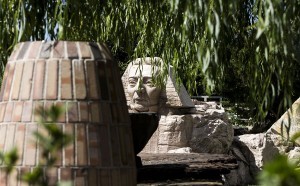Difference between revisions of "Gilgal Garden"
(Created page with "300px|thumb|right|frame|The Sphinx with the head of [[Joseph Smith, one of the sculptures in Gilgal Garden]] The '''Gilgal Sculpture Garden''' is...") |
|||
| Line 20: | Line 20: | ||
<videoflash>j0CUcz4H734&rel=0</videoflash> | <videoflash>j0CUcz4H734&rel=0</videoflash> | ||
| + | ==External Sources== | ||
| + | *[https://www.deseret.com/2005/6/24/19897889/salt-lake-s-secret-garden#thomas-childs-testimony-of-the-lds-church-and-joseph-smith-inspired-gilgal-gardens Deseret News, "Salt Lake's Secret Garden"] | ||
| + | |||
| + | *[https://en.wikipedia.org/wiki/Gilgal_Sculpture_Garden Wikipedia, "Gilgal Sculpture Garden"] | ||
| + | |||
| + | *[https://gilgalgarden.org/ Gilgal Sculpture Garden website] | ||
[[Category:Places of Church Interest]] | [[Category:Places of Church Interest]] | ||
Revision as of 18:21, 4 January 2022

The Gilgal Sculpture Garden is a small public city park located in Salt Lake City (749 East 500 South). Thomas Battersby Child Jr. began creating the park in 1945 at the age of 57, and worked on it full time during the 1950s as a testament of his love and devotion for The Church of Jesus Christ of Latter-day Saints.
Child named the garden Gilgal after the biblical location where Joshua ordered the Israelites to place twelve stones as a memorial. The name "Gilgal" is sometimes translated to mean "circle of standing stones," an appropriate appellation for a sculpture garden. Gilgal is also the name of a city and a valley in the Book of Mormon, a sacred scripture in The Church of Jesus Christ of Latter-Day Saints.[1]
The meaning behind the 12 sculptures and over 70 stones engraved with scriptures, poems, and literary texts, however, can be lost by the quirkiness of the garden. Child was a masonry contractor and not a classically trained artist, but he worked to put his thoughts and feelings into religious expression. He said, "If you want to be brought down to earth in your thinking and studying, try to make your thoughts express themselves with your hands.”[2]
Child was aware that many people would find Gilgal Garden strange, but hoped they would accept its challenge. “You don’t have to agree with me,” he explained. “You may think I am a nut, but I hope I have aroused your thinking and curiosity.”[3]
Many of the sculptures and quotations found at Gilgal refer to Latter-day Saint themes: the restoration of the Priesthood, the great Mormon migration west, and the many similarities Child saw between the ancient Israelites and his Latter-day Saint forefathers.
The park sits behind homes and businesses, adjacent to the Latter-day Saint meetinghouse where Child served as bishop for almost 20 years. Child himself would give tours of his garden and the family hosted dinners in the garden for family and friends.
After Child’s death in 1963, Child's neighbor, Grant Fetzer, who assisted in preliminary stonework, purchased the Child home and garden. The Fetzer family maintained the garden for 35 years, opening it for a few hours on Sundays, protecting it from vandals (although it was often vandalized) and cutting back overgrowth. But after maintenance and liability costs became too high, the Fetzers announced plans to sell it. Ideas included tearing it down for a condominium development.
A group of citizens called the Friends of Gilgal Garden, headed by Hortense Child Smith, the widow of Child's son, purchased an option to buy the property. The group arranged a $400,000 commitment from Salt Lake County and $100,000 each from The Church of Jesus Christ of Latter-day Saints and the George S. and Dolores Dore Eccles Foundation, covering the lion's share of the purchase price. However these commitments were conditioned on the garden becoming a city park, which Salt Lake City Council was reluctant to take because of a budget crunch. The property was eventually purchased for $679,000 and turned over to the city. On October 21, 2000, Gilgal Garden reopened as a city park. At a ceremony celebrating the occasion, Salt Lake City Mayor Rocky Anderson called the Garden "an absolute jewel."
The Friends of Gilgal Garden serve as the park’s curators. From 2001-2005 Utah Master Gardeners reduced the overgrowth of weeds on the property and made the grounds themselves pleasing. By 2005 restoration work had also begun on some of the sculptures.